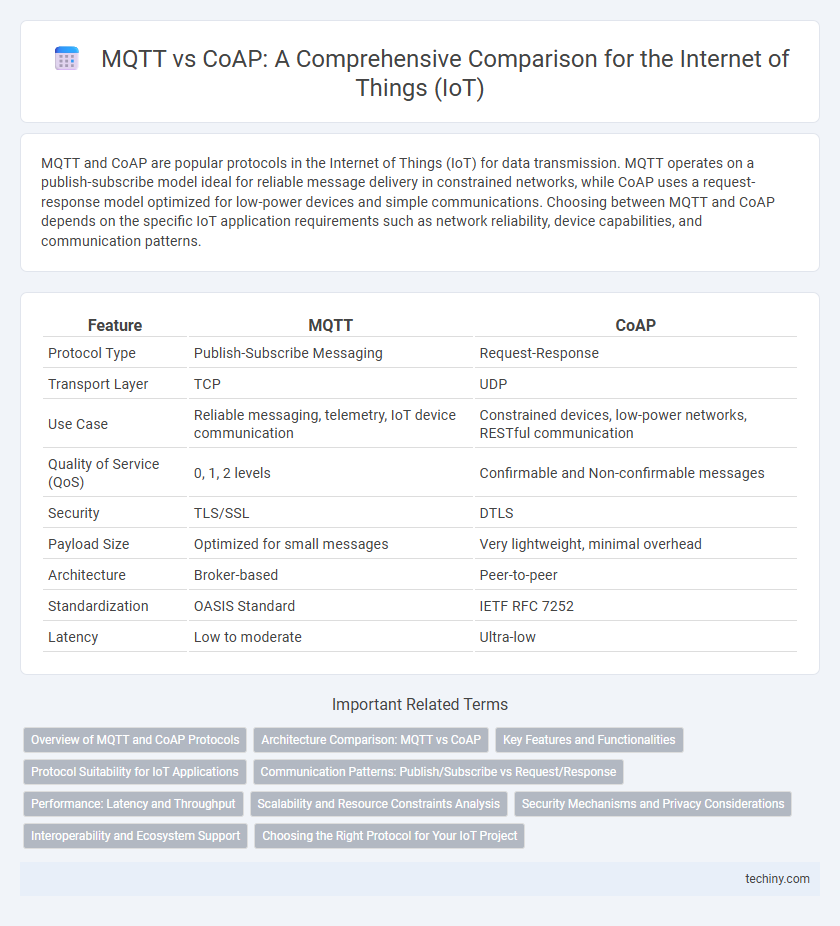MQTT and CoAP are popular protocols in the Internet of Things (IoT) for data transmission. MQTT operates on a publish-subscribe model ideal for reliable message delivery in constrained networks, while CoAP uses a request-response model optimized for low-power devices and simple communications. Choosing between MQTT and CoAP depends on the specific IoT application requirements such as network reliability, device capabilities, and communication patterns.
Table of Comparison
| Feature | MQTT | CoAP |
|---|---|---|
| Protocol Type | Publish-Subscribe Messaging | Request-Response |
| Transport Layer | TCP | UDP |
| Use Case | Reliable messaging, telemetry, IoT device communication | Constrained devices, low-power networks, RESTful communication |
| Quality of Service (QoS) | 0, 1, 2 levels | Confirmable and Non-confirmable messages |
| Security | TLS/SSL | DTLS |
| Payload Size | Optimized for small messages | Very lightweight, minimal overhead |
| Architecture | Broker-based | Peer-to-peer |
| Standardization | OASIS Standard | IETF RFC 7252 |
| Latency | Low to moderate | Ultra-low |
Overview of MQTT and CoAP Protocols
MQTT and CoAP are prominent protocols in the Internet of Things domain, designed for efficient machine-to-machine communication. MQTT operates on a publish-subscribe model, providing lightweight, reliable messaging with minimal bandwidth consumption, ideal for low-power devices. CoAP, based on RESTful architecture, uses UDP for request-response communication, optimizing resource-constrained environments through low overhead and multicast support.
Architecture Comparison: MQTT vs CoAP
MQTT features a publish-subscribe architecture with a central broker that manages message distribution, optimizing scalability and decoupling devices in IoT networks. CoAP utilizes a client-server architecture based on REST principles, enabling direct request-response communication well-suited for constrained devices and low-power networks. The broker-centric MQTT supports asynchronous messaging, while CoAP's architecture favors synchronous interactions with multicast capabilities for efficient device discovery and management.
Key Features and Functionalities
MQTT is a lightweight, publish-subscribe protocol designed for reliable message delivery in low-bandwidth, high-latency IoT environments, supporting Quality of Service (QoS) levels, persistent sessions, and retained messages. CoAP operates over UDP, enabling constrained devices to communicate through request/response patterns with built-in support for multicast, resource discovery, and low overhead for real-time applications. Both protocols optimize IoT communication, with MQTT excelling in telemetry and asynchronous messaging, while CoAP suits device management and constrained networks requiring efficient, RESTful interactions.
Protocol Suitability for IoT Applications
MQTT excels in IoT applications requiring reliable, low-bandwidth messaging through its lightweight publish-subscribe model and persistent session support. CoAP is designed for constrained devices and networks, using UDP for reduced overhead and enabling RESTful interactions suited for resource-limited environments. Choosing between MQTT and CoAP depends on the application's need for reliability, network conditions, and device constraints.
Communication Patterns: Publish/Subscribe vs Request/Response
MQTT employs a publish/subscribe communication pattern ideal for real-time, many-to-many messaging in IoT networks, enabling devices to asynchronously exchange data through a centralized broker. CoAP uses a request/response model optimized for constrained environments, allowing direct device-to-device interactions with low overhead. The choice between MQTT and CoAP hinges on factors like network topology, latency requirements, and device resource constraints.
Performance: Latency and Throughput
MQTT offers low latency and high throughput by using a lightweight publish-subscribe protocol optimized for unreliable networks, making it suitable for real-time IoT applications. CoAP, based on request-response over UDP, provides lower overhead but may experience higher latency due to retransmissions in lossy environments. Performance comparisons show MQTT excels in high-throughput scenarios, while CoAP is efficient for constrained devices with limited bandwidth.
Scalability and Resource Constraints Analysis
MQTT excels in scalability by supporting numerous devices through a lightweight publish-subscribe model, making it ideal for large-scale IoT deployments with diverse network conditions. CoAP, designed for constrained environments, offers efficient resource utilization by leveraging a RESTful architecture and UDP transport, reducing overhead for low-power, limited-memory devices. While MQTT performs reliably in complex systems, CoAP's minimal footprint is better suited for highly constrained IoT nodes with strict resource limitations.
Security Mechanisms and Privacy Considerations
MQTT employs TLS/SSL encryption and client authentication to secure message transmission, supporting robust access controls ideal for IoT environments requiring confidentiality and data integrity. CoAP relies on Datagram Transport Layer Security (DTLS) for encryption and authentication, optimized for constrained devices and low-power networks but may face limitations in scalability and complexity of authorization. Privacy considerations in MQTT center around secure broker management and access policies, whereas CoAP emphasizes minimizing metadata exposure and lightweight security suitable for resource-limited IoT applications.
Interoperability and Ecosystem Support
MQTT excels in interoperability due to its widespread adoption across diverse IoT platforms and robust support from cloud providers like AWS IoT, Microsoft Azure, and Google Cloud IoT. CoAP, designed for constrained devices and low-power networks, integrates seamlessly with RESTful architectures and offers strong compatibility with existing web protocols, enhancing interoperability in resource-limited environments. The extensive ecosystem support for MQTT includes mature client libraries and broker implementations, while CoAP benefits from integration with IP-based networks and emerging IoT standards such as 6LoWPAN and Thread.
Choosing the Right Protocol for Your IoT Project
MQTT excels in environments requiring reliable message delivery and low bandwidth, making it ideal for IoT projects with constrained networks and intermittent connectivity. CoAP, designed for resource-constrained devices, supports efficient RESTful communication and is suitable for applications needing multicast and low overhead, such as smart lighting and sensor networks. Selecting between MQTT and CoAP depends on factors like device capabilities, network reliability, and communication patterns specific to your IoT use case.
MQTT vs CoAP Infographic

 techiny.com
techiny.com